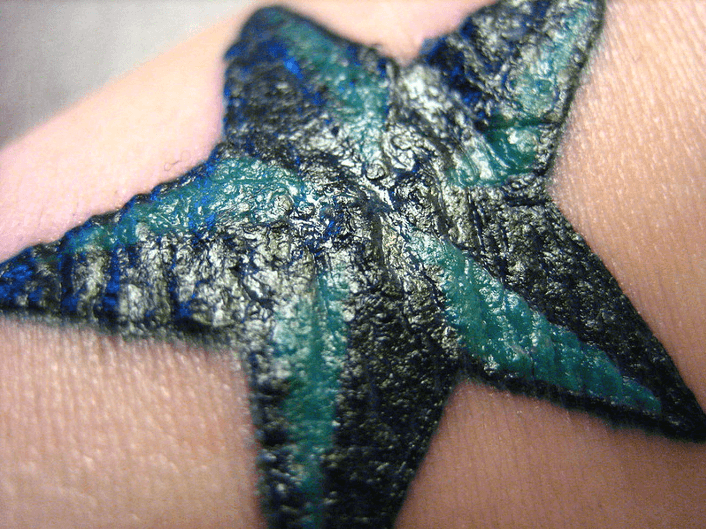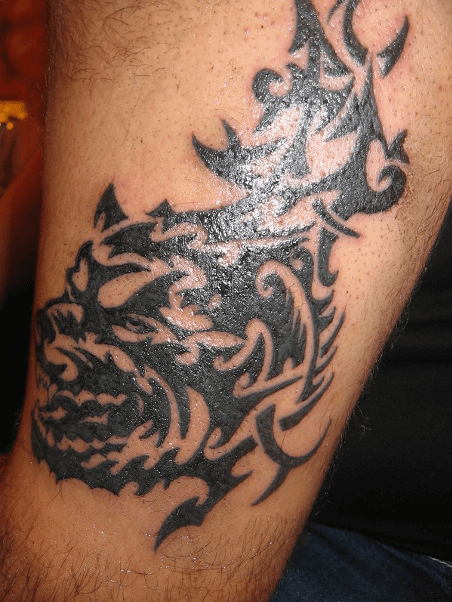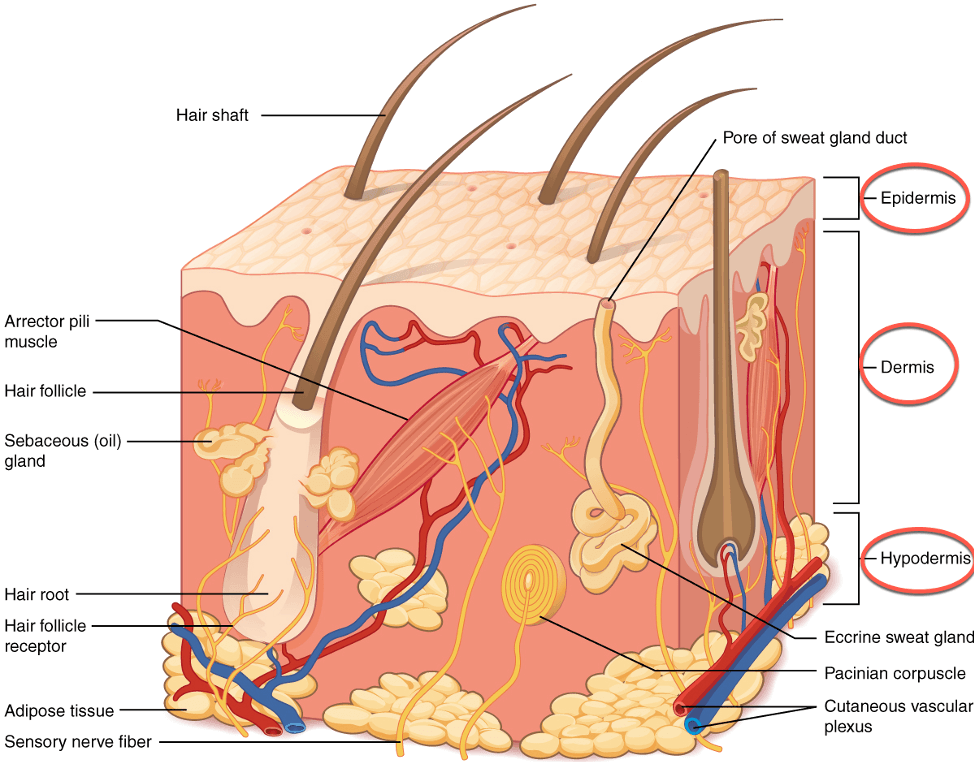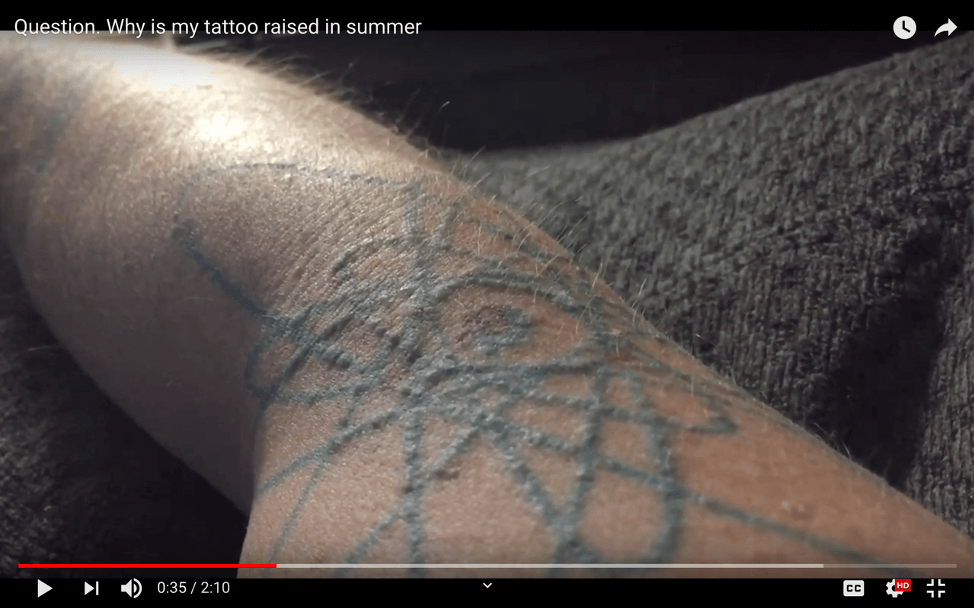The tattooing journey never really ends, does it? You think you’re out of the danger zone when you finally leave your tattooist’s studio, but oh no, your journey is just starting. Everyone goes through the itchy stage (some more than others). But some lucky souls totally skip out on the bumpy and raised tattoos part.
Well, if you’re reading this post, I suppose you’re one of the unlucky ones, but I sure hope I’m wrong! That said, if you want to find relief for your itchy and bumpy tatt, you know what to do… just scroll down the page for answers.
Page Contents
- What causes raised bumps on new tattoos – and how to fix
it?
- 1. It’s scabbing (which is totally normal in most cases)
- 2. Your new tattoo may be infected
- 3. Your new skin art is swelling
- 4. You’ve got a pre-existing or undiscovered skin condition
- 5. You’ve got some scarring going on
- 6. You’re having an allergic reaction
- 7. The weather’s changed, and it hates your tattoo
- 8. It’s just the way your body is
- Why am I still getting bumps and raises on old and fully healed tattoos?
- Found the solution for your raised tattoos?
What causes raised bumps on new tattoos – and how to fix it?
I’ll be honest with you: there are a LOT of possible reasons why tattoos – both old and new – turn into coloured skin bumps. I’ve tried my best to cover all possible reasons, but if you don’t find yours below, please consult with your doctor.
Here are 8 common reasons for bumps on new tattoos:
1. It’s scabbing (which is totally normal in most cases)

(A scabbing tattoo | Photo by Amanda from Flickr)
The moment your skin gets punctured by your tattooist’s needle, your body’s immune system springs into action. It tries to heal and patch the skin right under your tattooist’s nose. But you won’t see the full, crusty scab for another 1-3 days (depends on how big the tattoo is and how well your immune system works).
That said, when you run your fingertips over the scab, you’ll notice it’s a bit raised. It’s nothing to be alarmed about though. Underneath the ugly exterior is fresh new skin, which will be revealed (or shall we say ‘unveiled’) once the scab falls off.
How to treat?
It’s a waiting game, really. And in most cases, it’s going to be a short one. To come out on top, make sure you DON’T pick at the scabs. If you’re not dry healing, some moisturising lotion will help reduce your discomfort.
Otherwise, you risk pulling the skin off prematurely which can take some of the ink along with it. Plus, you’ll be delaying the healing process and the scabs will start all over again.
Pro tip: Use virgin coconut oil or a moisturising lotion to keep your skin hydrated and less irritated.
2. Your new tattoo may be infected
What a truly horrible way to welcome your new tattoo. But infections do happen, especially if you choose to hire a dodgy tattooist. Fortunately, the tattoo industry in the UK is heavily regulated, which helps combat the risks of bacterial infections.
Yes, professional tattooists do command a higher price, but in my opinion, it’s worth it. You are, after all, talking about getting inked permanently – you don’t want to tempt fate by hiring an inexperienced, amateur, wannabe ‘artist’.
So, what are the signs you’ve got a tattoo infection?
Well, in most cases, it starts with either a rash or an angry red bump around the new tattoo. Swelling, thick discharge, and pus are common signs, too. Oh, and if your tattoo’s starting to smell really nasty, it might be a sign of necrosis or tissue death.
According to this study by Drs. Dieckmann, Boone and Dahouk, the most common causes of bacterial infections were:
- Unhygienic conditions
- Non-sterile tattooing equipment
- Needle sharing
- Ink contamination
- Traditional Samoan tattooing
Which then resulted in infections like:
- Cellulitis
- Abscesses
- Erythema
- Tissue necrosis
- Septic shock
- Toxic shock syndrome
How to treat an infected tattoo?
Antibiotics and proper aftercare can usually treat minor infections. But if you start getting a fever along with chills and sweats, then PLEASE present yourself to the emergency ward or A&E department!
3. Your new skin art is swelling

(Fresh tattoo that’s swelling up a little | Photo by Simon Hammond)
Swelling isn’t entirely uncommon in new tattoos. More often than not, it’s the result of your body’s immune system at work. It’s an initial reaction designed to protect your skin – the blood vessels widen to ease blood flow so that the healing process can begin.
Some parts of the body are also more prone to swelling like the ankles and feet. Getting inked in these areas when you spend hours standing up can lead to intense swelling.
Also, tattoos done by heavy-handed tattooists can often lead to more bruising and swelling. This is because more pressure is applied to the skin which ultimately leads to your body responding by swelling up.
Swelling caused by a tattoo allergic reaction or even an infection is a different matter altogether. Please refer to the section above for possible solutions to your specific problem.
How to treat a swelling tattoo?
If swelling occurs during the first few days, don’t panic. It is but your body’s normal reaction to getting stung by needles thousands of times. You can try icing the area to find some relief or perhaps try elevating your legs if your tattoo’s on the lower side of your body.
However, if the swelling doesn’t subside after a few days, your new tattoo might be infected. Contact your GP if you think you’ve contracted an infection!
4. You’ve got a pre-existing or undiscovered skin condition
Ah, skin conditions – there’s a myriad of them. Not too surprising really, considering the genetic makeup that makes all of us unique. Some conditions you probably already know about – or even have – like acne, dermatitis and eczema.
Some skin conditions are visible, others not so much. A professional tattoo artist will inspect your skin before doing anything with it. So, if your skin’s acting up after getting the tattoo, it’s probably caused by the tattoo (new reaction). Or, it’s been there all along (dormant) but was triggered by the ink insertion.
What’s the remedy?
First, you need to know what condition is causing the reaction. If you have dermatitis, you’re probably allergic to the ink or the needles or even your tattooist’s gloves. Some skin disorders are pretty fickle and can be triggered by the smallest things. For skin issues, it’s best to speak with a dermatologist.
5. You’ve got some scarring going on
As long as tattoo ink is inserted at the right skin layer (the dermis), there should be no scarring. However, if your tattooist’s a bit heavy-handed or inexperienced, they might puncture your skin too deeply. Instead of the dermis, they’ll go deep into the hypodermis or the fatty layer. Doing so can cause tattoo scarring.

What happens with scarring is that your skin attempts to repair the damage. But instead of regular skin cells, your body produces collagen to patch up the wound (which is what your tattoo technical is). Collagen is tougher and thicker than normal skin tissue, this is why when your tattoo scars underneath, it raises the skin by quite a bit.
Keloids are another possible side effect of a tattoo done poorly. Some people are more prone to this type of scarring than others. If you frequently get keloids, you should speak with your tattooist first; many of them don’t tattoo on keloid-prone individuals.
How to fix?
Unfortunately, there’s no cure for scarred, bumpy tattoos. You can attempt to have the tattoo redone via touch-up, but you risk getting even more scarring this way. You can apply lotions and creams to hydrate and soften the skin, or even cover it up with makeup, but none of these are permanent solutions.
6. You’re having an allergic reaction
Oh, welp. Tough luck! An allergic reaction can be anything from super mild to extremely severe. If your reaction falls on the mild side of things (maybe just a slight swelling), then good for you. Otherwise, go to the hospital nearest you, which is the case with this patient who went straight from the tattooist to hospital in just 5 hours!
The most common cause of allergic reaction is tattoo ink. If you go to a reputable studio, they’d most likely use hypoallergenic ink that has little to no common allergens in it. However, some coloured inks (usually red) use ingredients that can cause skin irritations, which often leads to raised tattoos.
On the other hand, if you had your friend do a stick and poke tattoo at home, then you suddenly have a whole host of possible irritants and allergens to look into. For instance, how clean was the living room/bedroom/kitchen where the tattoo was done? Was a clean needle used? What kind of ink was used (not pen ink, I hope!)?
Read here: How long do stick and poke tattoos last?
How to fix?
Some symptoms may go away after a few hours, without you needing to do anything. In many cases, a topical steroid ointment or antihistamine can do wonders, and provide relief straight away. But before doing anything, get your tattooist’s opinion first. You don’t want to apply anything that can damage the ink in the long run.
For truly severe allergic reactions, like progressive swelling, burning pain, vomiting, and other horrible symptoms, seek treatment straight away!
7. The weather’s changed, and it hates your tattoo
Your beloved tattoo rarely gets a break, doesn’t it? Even the weather can cause undesirable reactions. Whether it’s hot or freezing outside, it doesn’t matter, someone’s tattoo is bound to get a reaction.
You just need to wait and see which end of the weather spectrum your new ink will react to. Once you determine that, try not to breach the offending temperatures unless you specifically want your tattoo to bump up!
Here’s what happens to skin when seasons change:
Summer
Temperatures and humidity levels rise during summer. This makes your skin swell and stretch a little bit, which can cause your tattoo to itch. If you’re going out into the sun, cover up your tattoo. If the area is going to be exposed, apply sunscreen with high sun protection factor (SPF).
Banana Boat’s SunComfort Sunscreen is easy to apply. Just spray it on your tattoo (and other sun-exposed body parts), rub it in, and you’ll be protected from the harmful rays of the sun!
This is a great sunscreen for both new and old tattoos! (click image to buy)
Winter
When temperatures fall, the skin tends to dry up. And your tattoo can develop a rash and itch like no one’s business; this may be due to the ink reacting with the cold. This is where a handy moisturising lotion comes in.
How to treat?
Move to another part of the world? Just kidding. If you’re getting reactions during summer, perhaps try to minimise your exposure to the sun. If it’s unavoidable, make sure your tattoo is well protected (see our recommended sunscreen above). For those afflicted by cold temperatures, staying warm indoors may provide some relief for your bumpy and raised tattoo.
8. It’s just the way your body is
Everyone’s body chemistry is different. It’s part of what makes each one of us unique, what makes us truly individuals. However, from a tattoo standpoint, this can cause all sorts of problems.
Now, there’s no exact formula to how your skin will react to a brand-new tattoo, but here’s a good one to start with:
Tattoo ink + tattooist’s skill + genetics + body chemistry = your body’s unique reaction to the tattooing process
Don’t forget, the tattoo ink inserted in your skin is literally a foreign object. Your body may not immediately play nice with it, and it’s showing its displeasure by causing all sorts of bumps and raises in your skin.
How to fix?
Well, this one’s tough. The tattoo ink’s already inside you. The tattooist’s skill (or lack of it) has been applied. And you can’t very well fix your genes or your body chemistry. If your raised tattoo shows no sign of going back to normal and is causing you pain or discomfort, please speak to your GP immediately.
Why am I still getting bumps and raises on old and fully healed tattoos?
Raised new tattoos aren’t all that surprising. I mean, you can expect some swelling to happen at some point after getting the tattoo. But when it happens a few months or even years down the line, well, I might be concerned too.
For instance, Alan d’Eon says in his video that his tattoo gets itchy during the month of July. Apparently, this seasonal itch has been bothering him for the past 6 years! Here’s a screengrab from his Youtube video:

That can’t be too comfortable. He says it’s not scarring, and the tattoo is completely normal the rest of the year. Nobody knows what’s going on, but I personally think it’s just his body’s unique reaction to the tattoo.
Note: If you do have some theories, please feel free to comment on the video. Let’s help the poor guy get some relief!
Now, here’s the thing – that tattoo ink in your skin, no matter how long it’s been there, it’s still considered a foreign object by your body. This means that over time as your environment and your body chemistry change, that ink may cause adverse – and delayed – reactions to your body.
Found the solution for your raised tattoos?
In most cases, bumpy and raised tattoos are no cause for concern. But if your condition doesn’t improve in the next few days, something might be going on. Listen to what your body’s telling you. If need be, speak to your tattooist or your GP.


I have ALL the symptomps you mentioned,except fever.I use every creme known to men to reliefe the itch.The only thing which “help”is scratch bumpy part of the tattoo untill you see flesh.After that,be patient for a couple of weeks,wait for crust to appeare and go,and itchy and bumpy part will leave you alone.The final and safe solution is Skynial method which take the tattoo color out from you skin
Skinial,not Skynial,please,fix my grammar🙂